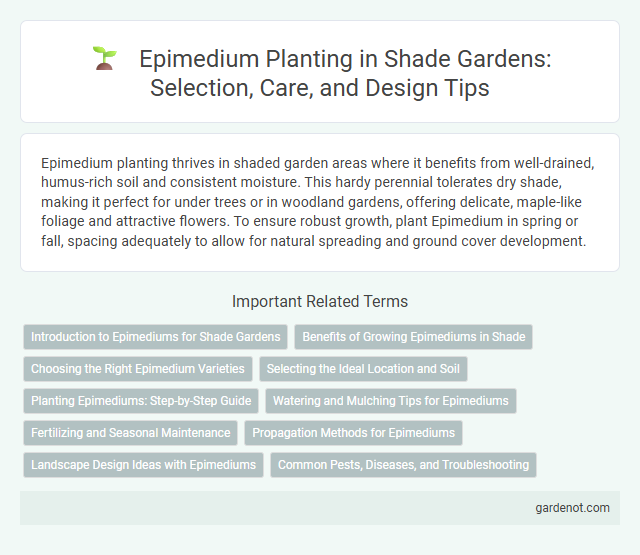Epimedium planting thrives in shaded garden areas where it benefits from well-drained, humus-rich soil and consistent moisture. This hardy perennial tolerates dry shade, making it perfect for under trees or in woodland gardens, offering delicate, maple-like foliage and attractive flowers. To ensure robust growth, plant Epimedium in spring or fall, spacing adequately to allow for natural spreading and ground cover development.
Introduction to Epimediums for Shade Gardens
Epimediums, commonly known as barrenwort or bishop's hat, are ideal perennial plants for shade gardens due to their exceptional tolerance to low light and drought. These resilient plants feature delicate, heart-shaped leaves and produce graceful clusters of bell-shaped flowers in spring, enhancing the aesthetic appeal of shaded areas. Epimediums thrive in well-drained soil enriched with organic matter, making them perfect groundcovers that suppress weeds and maintain soil moisture under trees or alongside shaded pathways.
Benefits of Growing Epimediums in Shade
Epimediums thrive in shade gardens, providing excellent ground cover with their dense, evergreen foliage that suppresses weeds and conserves soil moisture. Their delicate, spurred flowers bloom in early spring, attracting pollinators such as bees and butterflies, which enhances garden biodiversity. These plants are highly tolerant of dry shade and poor soil conditions, making them low-maintenance and ideal for under trees or in shady borders.
Choosing the Right Epimedium Varieties
Selecting the right Epimedium varieties for a shade garden enhances both aesthetic appeal and adaptability to low-light conditions. Varieties like Epimedium x versicolor 'Sulphureum' and Epimedium grandiflorum offer vibrant foliage and delicate flowers that thrive under tree canopies and in shaded borders. Choosing species with varying bloom times and leaf colors ensures year-round interest and maximizes the plant's durability in diverse shade environments.
Selecting the Ideal Location and Soil
Epimedium thrives best in shaded areas with dappled sunlight, making woodland gardens or under deciduous trees ideal locations. The soil should be well-drained, rich in organic matter, and slightly acidic to neutral with a pH of 6.0 to 7.0 to promote healthy root development. Consistently moist but not waterlogged conditions support robust growth and vibrant foliage.
Planting Epimediums: Step-by-Step Guide
Plant Epimediums in well-drained, humus-rich soil with partial to full shade, ensuring spacing of 12-18 inches to accommodate growth. Dig holes twice the root ball size and position crowns just below the soil surface to promote healthy root establishment. Water thoroughly after planting and mulch with organic material to retain moisture and suppress weeds.
Watering and Mulching Tips for Epimediums
Epimediums thrive in consistently moist but well-drained soil, requiring regular watering to maintain hydration, especially during dry spells. Applying a 2-3 inch layer of organic mulch, such as shredded leaves or bark, helps retain soil moisture, regulate temperature, and suppress weeds around the plant base. Mulching in early spring enhances root health by preventing moisture loss and providing nutrients as it decomposes.
Fertilizing and Seasonal Maintenance
Epimedium thrives in rich, well-drained soil with organic matter, benefiting from a balanced, slow-release fertilizer applied in early spring to support vigorous growth. Mulching around the plants helps retain moisture and regulate soil temperature during seasonal changes, while removing old foliage in late winter encourages fresh shoots and reduces disease risk. Regular watering during dry spells and avoiding excessive nitrogen fertilizers maintain optimal foliage health and flowering performance in shaded garden areas.
Propagation Methods for Epimediums
Epimediums propagate effectively through division and seed sowing, with division being the most reliable and fastest method to establish mature plants. Dividing healthy clumps in early spring or fall ensures vigorous growth and maintains genetic consistency, while seed propagation, though slower, allows for genetic variation and can be done by sowing fresh seeds in a shaded, moist environment. Tissue culture is another advanced technique used predominantly in commercial settings to produce disease-free, uniform plants efficiently.
Landscape Design Ideas with Epimediums
Epimediums thrive in shady garden areas, making them ideal for ground cover in landscape designs where dappled sunlight or dense shade prevails. Their delicate, heart-shaped leaves and vibrant spring flowers add texture and seasonal interest, complementing ferns, hostas, and other shade-loving plants. Incorporating Epimediums into woodland garden beds or under deciduous trees enhances the naturalistic aesthetic while providing erosion control and low-maintenance greenery.
Common Pests, Diseases, and Troubleshooting
Epimedium plants in shade gardens commonly face pests such as aphids and slugs, which can cause leaf distortion and damage. Fungal diseases like powdery mildew and leaf spot may develop in overly moist conditions, leading to discoloration and defoliation. Effective troubleshooting includes improving air circulation, applying organic insecticides, and maintaining proper soil drainage to prevent pest and disease outbreaks.
Epimedium planting Infographic

 gardenot.com
gardenot.com